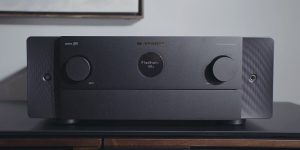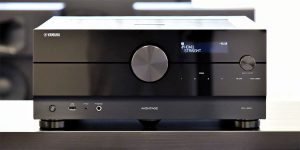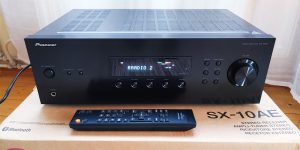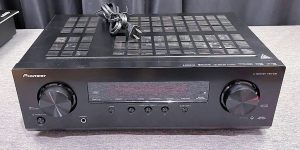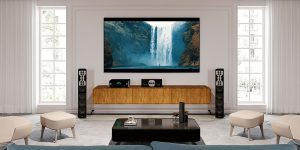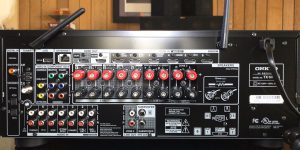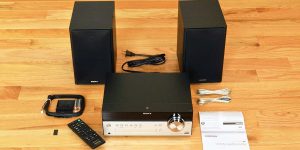Choosing a proper AV receiver is key to building a home entertainment system that allows you to enjoy high-quality sound for movies, games, and music. My today’s review covers the best 2 zone receivers according to various criteria.
Multiroom is no longer part of the elite audio system of expensive apartments or houses. Today, it has become a popular way to reach hi-end sound quality at home. With the help of the receiver, you can use the speakers in multiple rooms and play different content in each zone.
So, I am going to share my experience of using 4 different AV Receivers and evaluate their ability to manage multi-zone setups.
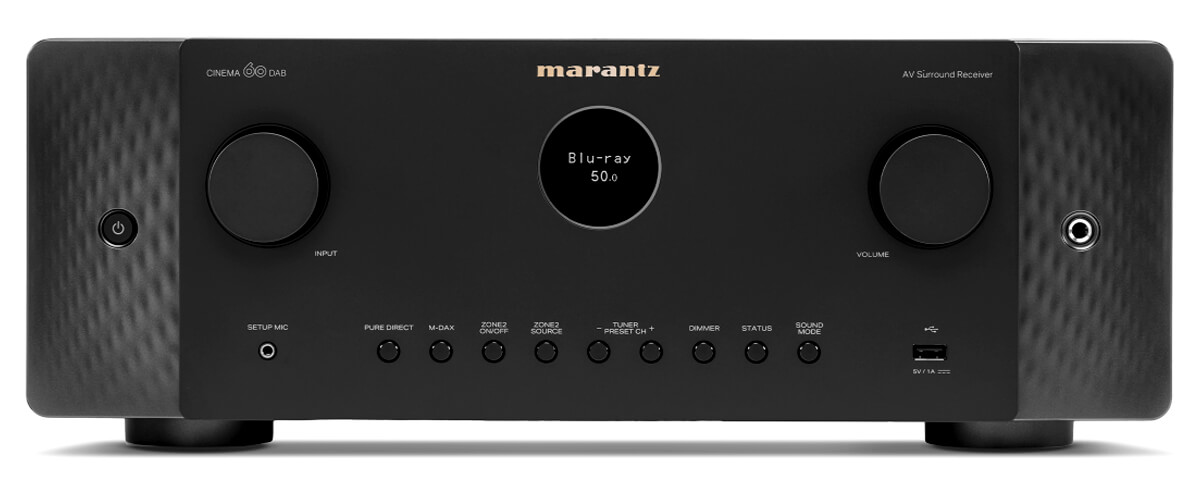
Read the full review.
Dual zone AV receivers comparison table
| Name | Channels | Power output | HDMI in/out | Bluetooth/Wi-Fi | Review |
|---|---|---|---|---|---|
| Marantz Cinema 60 best overall | 7.2 | 100W/8 Ohm, 140W/6 Ohm | 6/2 | yes/yes | Review |
| Denon AVR-X1700H budget choice | 7.2 | 80W/8 Ohm, 120W/6 Ohm | 6/1 | yes/yes | Review |
| Pioneer Elite VSX-LX305 | 7.2 | 100W/8 Ohm, 225W/6 Ohm | 6/2 | yes/yes | Review |
| Yamaha RX-A2A | 7.2 | 80W/8 Ohm | 7/1 | yes/yes | Review |
What is a multi-zone feature?
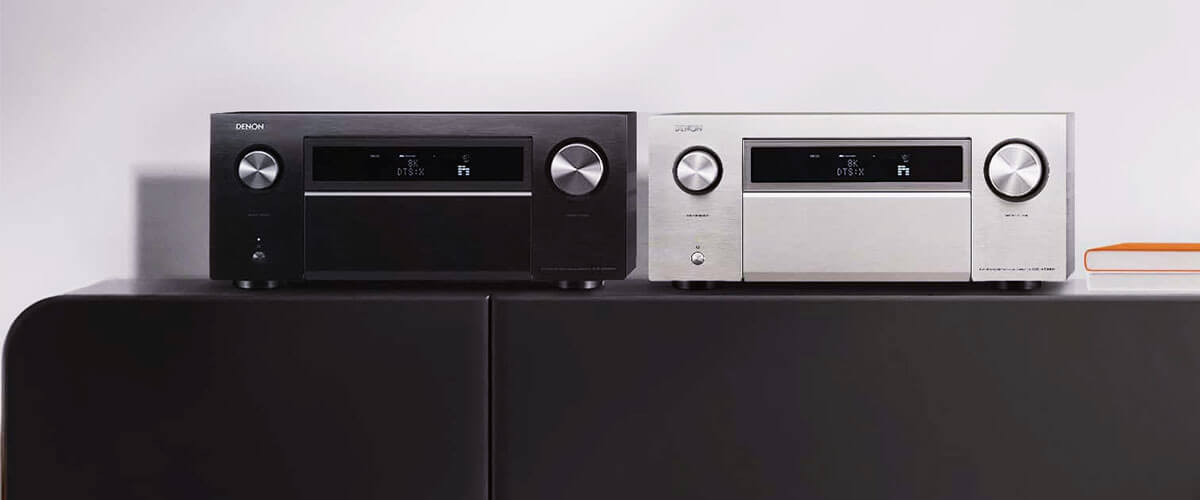
Multi-zone audio distribution allows home AV receivers to send signals to speakers or individual audio systems in different rooms. These zones can run separate multimedia simultaneously with various sets of channels. Depending on the type and model of a receiver, a multi-zone function can be implemented differently.
The simplest multi-room system may consist of a standard set of devices. The list includes an AV receiver and wireless speakers. Such a setup allows you to play music in multiple rooms, using a single sound source, such as a smartphone or tablet, and synchronizing the sound with special software.
There can be signal sources, including cable TV, a Blu-Ray player, or a home PC. The user can freely switch between different sound sources, and the audio can be simultaneously transmitted to several devices. For added convenience, individual devices can be combined into zones. Each of them gets its own set of sound settings and a single sound source. On the market, you will often find 2-zone receivers transmitting specific signals from different source devices to two separate rooms. For example, you can connect the Blu-ray player and TV to the same AV receiver. Therefore, with a dual zone receiver, you can watch a music concert on TV while your kids watch a Blu-ray cartoon in another room.
How does multi-zone work?
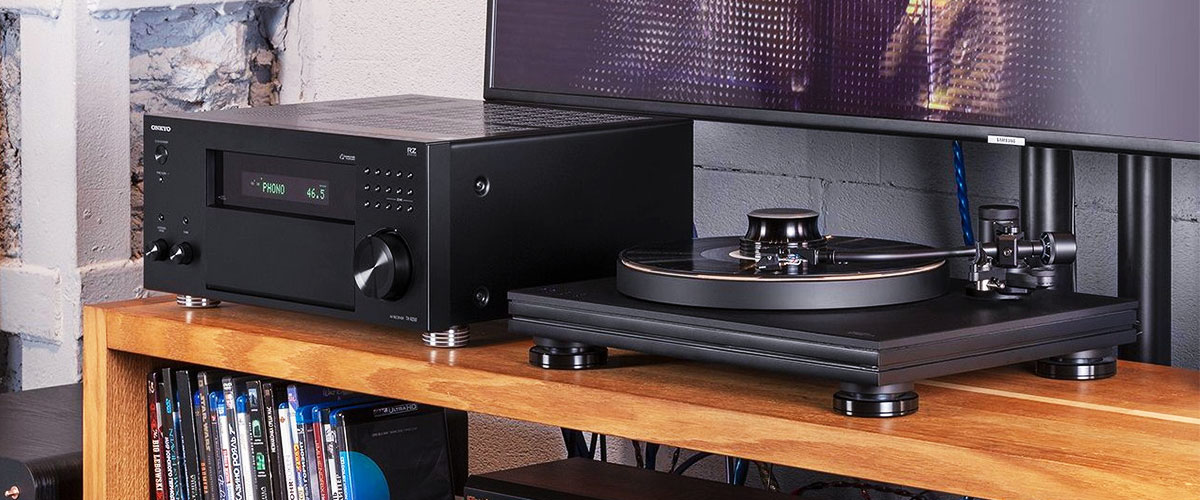
There are 3 main ways of implementing the multi-zone sound distribution feature. The most straightforward approach requires running a 7.1 channel receiver in the 5.1 channel mode for the main room. Thus, leaving additional two channels for speakers located in the second one. Some receivers have full 7.1 mode capability in the main room when the second one is not in use.
The second approach is when a receiver has a built-in preamplified line or lines. In this case, you need to connect it to another receiver in the second room to amplify the sound system. The control over the setup is achieved through the primary device.
The most expensive approach allows having several preamplified lines. They require another receiver and separate sets of speakers in each zone. However, in the case of 9+ channel models, one may use 5.1 mode in their main room and split the remaining 4 changes for two other rooms (2 channels in each room). Thus, they won’t need additional receivers to run a multi-room setup.
| Table of content |
|---|
| Marantz Cinema 60 – best overall |
| Denon AVR-X1700H – budget choice |
| Pioneer Elite VSX-LX305 |
| Yamaha RX-A2A |
Best 2 zone receiver reviews
Marantz Cinema 60 – best overall

Marantz Cinema 60 is an interesting product in the company’s most famous classic AV receiver series. The device arguably is the optimal solution for home theaters in the product line. With an ergonomic design and minimalistic front panel, the receiver supports the majority of modern standards and features.
Although this model has 7 channels only, it is still in the middle segment in the price category and is therefore made reliably. But ever since Marantz started making designs with round LCDs, I’m just pissed at them. You won’t see anything on it unless you are near the AVR. The buttons are highlighted on the front panel but quite small, and yet everything works as if you have a more expensive device in front of you.
The Cinema 60 is a 7.2 channel AV receiver, offering 100W per channel (8 Ohm, 20Hz-20kHz, THD: 0.08%, 2 ch. drive, Bi-amp). The device uses 32-bit AKM AK4458 DACs. Built-in Marantz’s Hyper Dynamic Amplifier Modules (HDAMs) allow for optimum fidelity, resulting in a good dynamic range. In addition, the receiver supports analog and HDMI scaling (up to 8K 60/50).
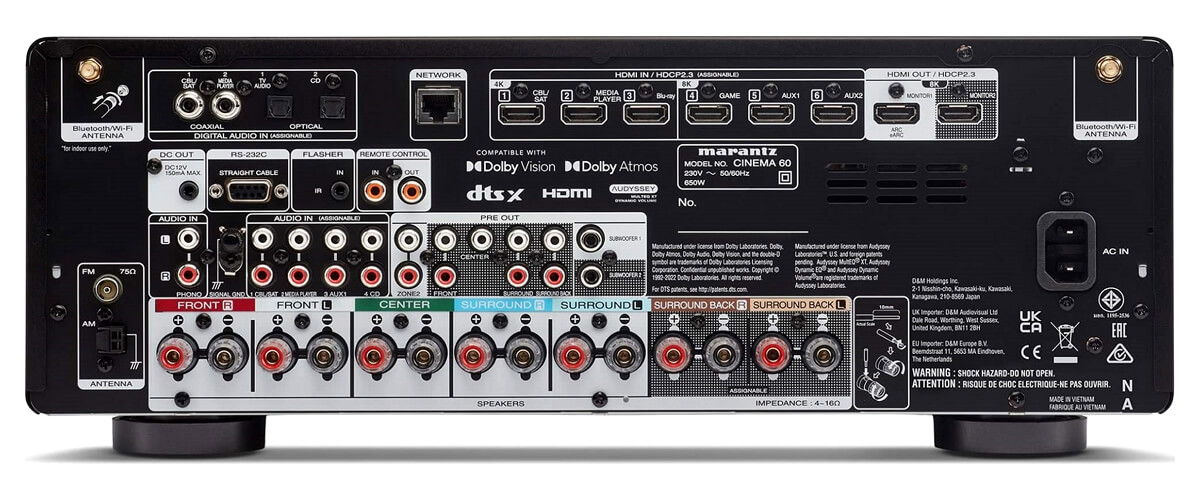
The Marantz Cinema 60 supports a Zone 2 feature and HEOS, which allowed me to create a fully independent sound system in another room, but only with two speakers. A single multi-room output is located on the back. In my case, I connected it with my HEOS speakers. The amplifier switched to a 5.1 channel mode in the main theater room, and I had 2 speakers in another room, creating a separate zone. The receiver also supports Airplay 2 capable speakers, offering pretty flexible options for setting multi-room zones.
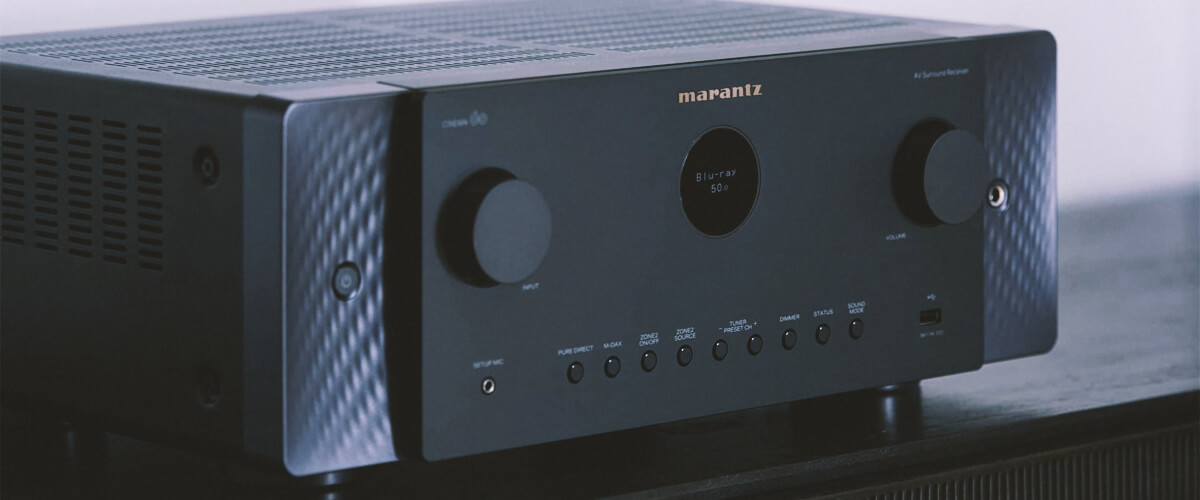
This model continues the company’s trend and has capable streaming capabilities by supporting all the most popular service providers, such as Tidal, Deezer, Amazon prime music, TuneIn, and others. The SR5015 can be controlled using the remote control & supports voice control from Siri, Alexa, Google Assistant, and the Audyssey MultEQ Editor App for audio adjustment.
During testing, this multi-room receiver proved worthy, coping with all tasks, and provided high-quality sound and decent control over it. It is impossible to compare the sound of the 7-channel Cinema 60 with wider systems, but it is the king of the party in its category. Frequency balance is evident in the instruments I use, and in practice, you can hear the details and layering of background noise in any movie. I also liked its warm tone in stereo, as I love acoustic instruments. The AVR coolly brings out vocals and guitar strings as if you were in a recording booth.
Overall, the Cinema 60 is the best 2 zone receiver, offering everything you need to build a two-room multi-zone system. It’s proven to be great for movies and music, has a very good 100W of power (while not wheezing when you turn up the volume like cheaper options), and has a full range of modern features (8K video and support for streaming services). You won’t even have to mess around with settings, as Audyssey MultEQ will do everything for you. But it’s prone to overheating.
Key specs
- Channels: 7.2.
- Power output: 100W/8 Ohm, 140W/6 Ohm.
- HDMI inputs/outputs: 6/2.
- Video functions: 8K/60Hz, 4K/60Hz, 4K/120Hz, HDMI Upscaling up to 8K.
- Bluetooth/Wi-Fi: yes/yes.
- Streaming services: AirPlay 2, Spotify, TuneIn, Deezer, Tidal, Netflix, Amazon Prime.
- Supports: HDMI ARC, HDMI eARC, HDMI CEC, HDCP2.3, HDR10+, Dolby Vision.
- Surround sound: DTS:X, DTS Virtual:X, Dolby Atmos, DTS HD Master, Dolby TrueHD.
Pros
- Supports modern surround sound formats.
- Audyssey MultEQ Editor App.
- Voice control support.
Cons
- Lack of front HDMI input.
- Tends to overheat.
Denon AVR-X1700H – budget choice
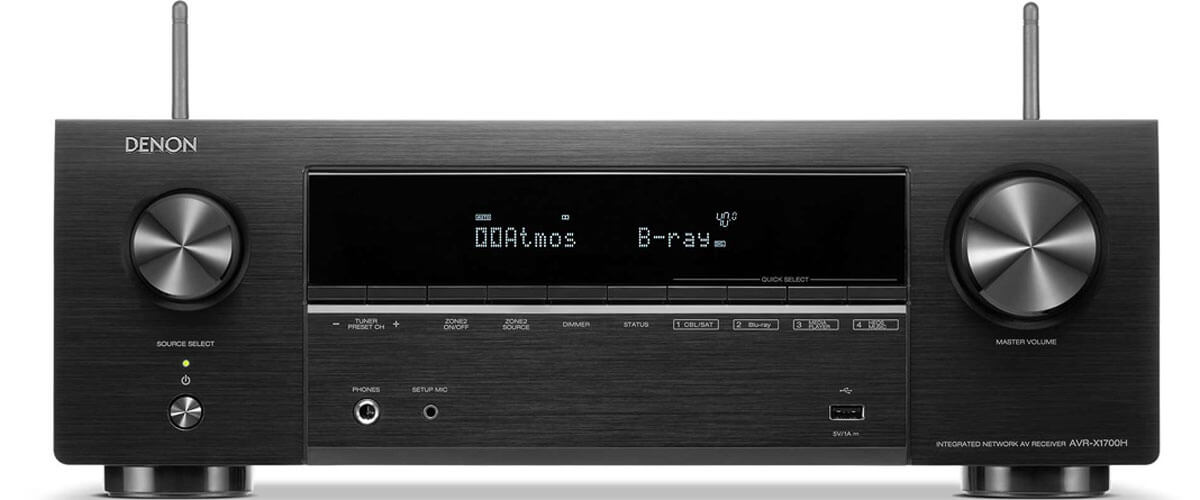
AVR-X1700H is one of the most affordable models from the X line of Denon receivers that I found in my search . It came after the more advanced X2700H and had pretty good features but offered fewer functions than more expensive models.
The AVR-X1700H supports 175 watts (6 ohms, 1 kHz, THD: 10%) for one channel, 120 watts (6 ohms, 1 kHz, THD: 0.7%) for 2 channels, and 80 watts (8 ohms, 20 Hz – 20 kHz, THD: 0.08%) also for 2 channels. In addition, the model supports Bi-amp Drive.
Denon’s design hasn’t changed since the time of the dinosaurs, so I can emphasize the uncomfortable buttons in manual control, which force you to touch the LCD with your fingers. But, unlike the Marantz SR5015, the screen here is clearly viewable. The construction is solid, quite heavy, and sturdy, and the volume and source controls are very smooth and nuanced.
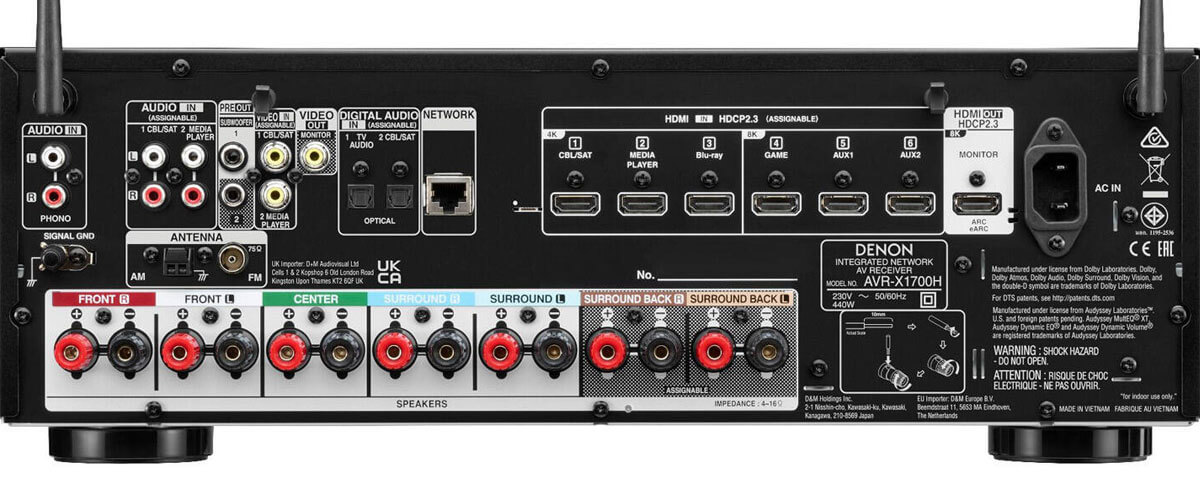
This AV receiver comes with HEOS Multiroom. But I connected it using the built-in Zone 2 function. So, in my setup, the receiver worked in a 5.1-channel mode in the main zone with my Blu-ray player and got 2 channels (surround back L+R) for my second room, where I played games on Xbox. So, considering its price, I got a workable and sustainable multi-room setup for different purposes at a fair price.
The receiver also supports Wi-Fi Audio Streaming (Windows Playto and Airplay2), A2DP Bluetooth, internet radio, Tidal, Deezer, Spotify, Amazon Prime music, and other services.
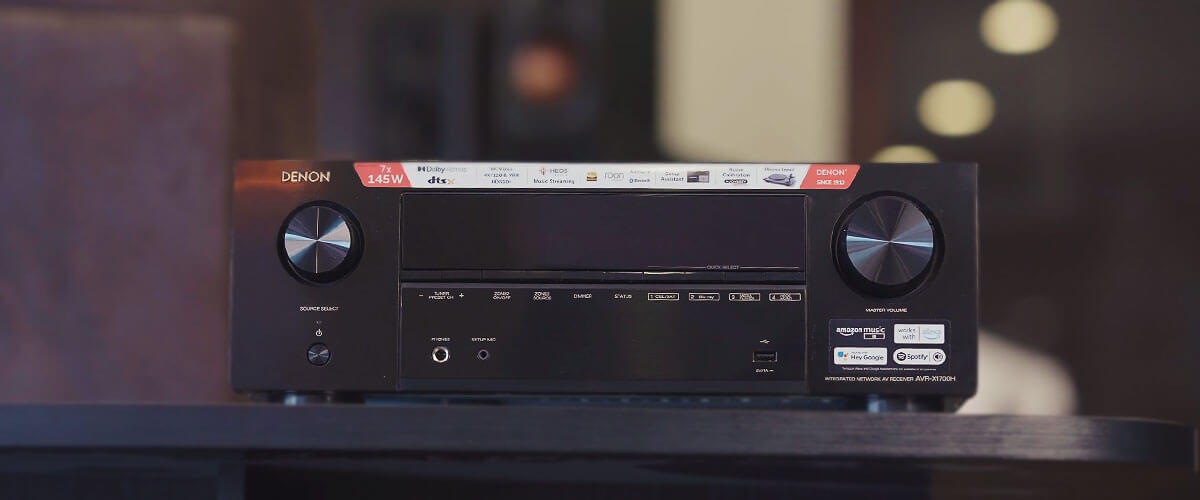
3 HDMI inputs support 8K video at 60Hz, and 3 other 4K support up to 120Hz. As a gamer, I was happy to see VRR, QFT, and ALLM in this budget. I wasn’t disappointed with my gaming experience and definitely can recommend this receiver for it. The AVR-X1700H is pretty simple to use as it has easy-to-understand instructions. When I connected the receiver to my TV, it showed me the Denon Setup Assistant, which helped to set up a multi-zone environment quickly and correctly.
As for the sound of the receiver, even though it is a budget option of my selection – it is one of my favorites. The warm, realistic sound of the brand is reflected in every movie, giving a sense of presence. As I watched scenes from The Quick and the Dead, it was like bullets were flying past my ears. The dialog is very crisp, but even the dust flying from under the feet of the shooters seems like it’s about to hit your eyes. Stereo, like the Marantz SR5015, is on the mark, but when using Bluetooth, the quality drops.
When considering inexpensive receivers, the AVR-X1700H is far superior to the other models in this lineup regarding technology and sound capabilities. With this model, Denon has made a qualitative leap over its analogs, offering a decent set of features at a modest budget. Half of the HDMI ports support 8K video, the receiver is good for gaming, and sound customization is also effortless. Its internal components are simpler than the winner of the rating. Still, it’s a reliable machine, especially considering its low price (even lower today, as the model is going into circulation). I don’t see the point in buying something expensive with 7 channels when there is a budget option from Denon.
Key specs
- Channels: 7.2.
- Power output: 80W/8 Ohm, 120W/6 Ohm.
- HDMI inputs/outputs: 6/1.
- Video functions: 8K/60Hz, 4K/60Hz, 4K/120Hz, HDMI Upscaling up to 8K.
- Bluetooth/Wi-Fi: yes/yes.
- Streaming services: AirPlay 2, Spotify, TuneIn, Deezer, Tidal, Netflix, Amazon Prime.
- Supports: HDMI ARC, HDMI eARC, HDMI CEC, HDCP2.3, HDR10+, Dolby Vision.
- Surround sound: DTS:X, DTS Virtual:X, Dolby Atmos, DTS HD Master, Dolby TrueHD.
Pros
- Audyssey Room Correction is very useful for adjusting speakers.
- Audyssey MultEQ XT delivers good results.
- HDMI supports 8K videos.
- Support for game functions.
Cons
- Lack of DAB+ tuner for a digital radio signal.
- Decreased sound quality when using Bluetooth.
Pioneer Elite VSX-LX305
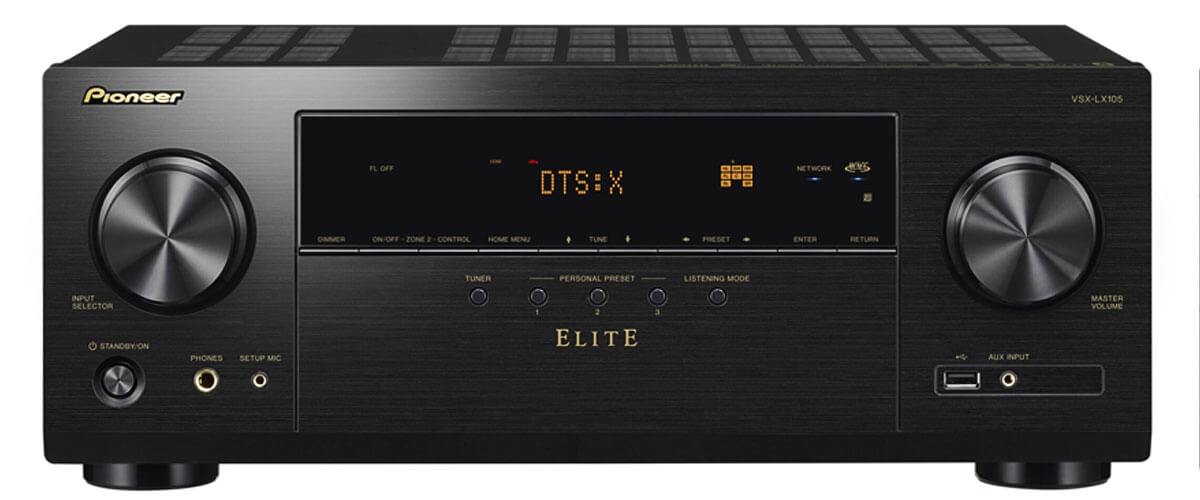
Pioneer is a well-known company that has operated for decades in the AV receiver industry. The VSX-LX 305 9.2 channel AVR is their top-of-the-range model offering quality sound and video features for home entertainment systems.
I call brand receivers tin men, as they are reliable and uncomplicated. The VSX-LX 305 is quite old-fashioned, and like the Denon AVR-X1700H, the buttons are located directly below the LCD.
The receiver offers 100 Watts (8 ohms, 20Hz-20kHz, THD: 0.08%, 2-channel driven) and 225 W per channel (6 ohms, 1kHz, THD: 10%, a single channel driven). Powerful TI PCM1690IDCARQ1 has been used for DAC and supports 8-channel, 192kHz, and 24-bit. VSX-LX305 supports the bi-amping of front channels. However, this feature significantly decreases the surrounding configurations due to the lack of pre-amplified outs.
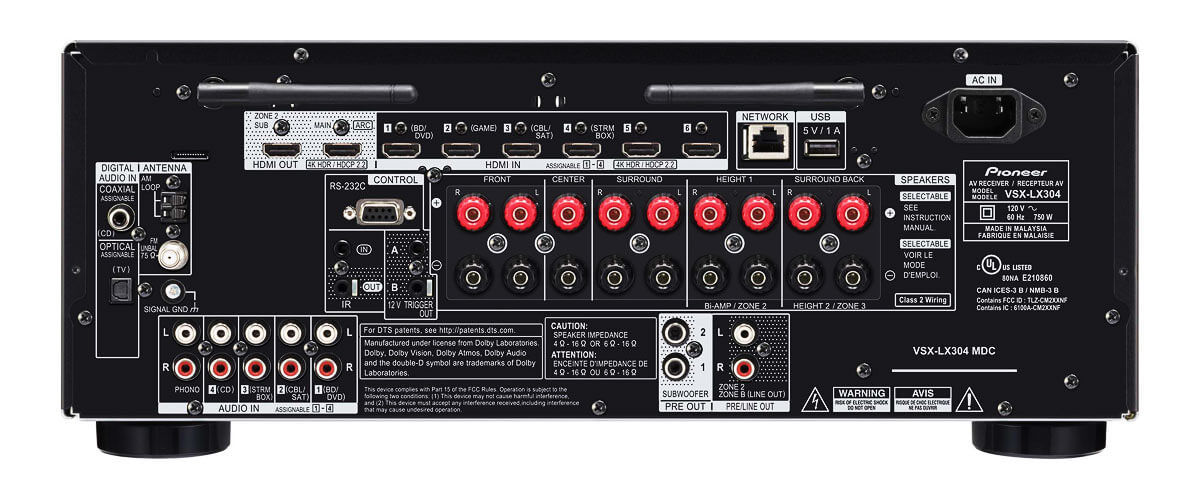
I integrated the receiver with my Apple Airplay ecosystem without any problems. With 9 channels onboard, the amplifier supports up to 3 separate zones, with 5.1 in the main room and 2 channels in the two additional ones. Therefore, it is more capable than only two-zone receivers mentioned in this review. Only Zone 1 supports 8K/60. The other two can work with 4K/120 fps with two active HDMI.
The rear panel includes 6 HDMI (only ports numbered from 1 to 4 are assignable) and 2 HDMI outputs that can be set as ZONE 2 video out. The front panel offers a single HDMI (not assignable, 4k max resolution) and USB ports. VSX-LX305 also supports Wi-Fi and Bluetooth connections. In addition, the device works with Alexa, Google, and Apple AirPlay.
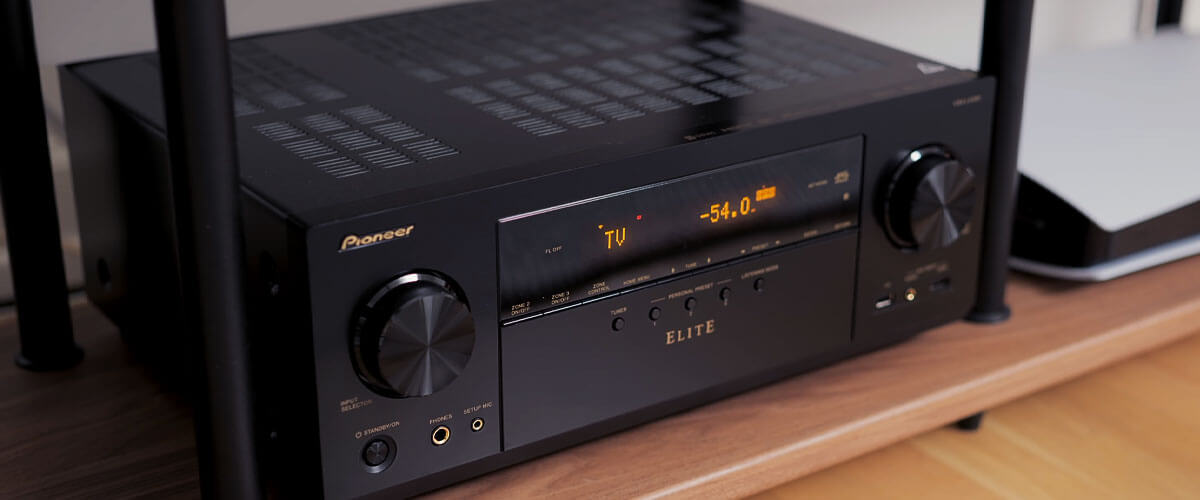
With my setup, Pioneer Elite VSX-LX305 provided rich and natural colors. It supports various video quality enhancement technologies. I watched several movies, and the receiver created a magnificent atmosphere. It upscaled the movie from 1080p to 4k without me noticing any quality, contrast, or color saturation loss.
The VSX-LX305’s sound is simple. The 9 channels do their job, and you have an immersive experience, but compared to the models above, the overall soundstage is simpler. It’s flat and not as varied in tone, although the bass tone is quite powerful.
The main difference between the brand’s products and those described above is decent quality and more features at a low cost. Pioneer VSX-LX305 is a modern solution that supports current technologies and codecs, has 9 channels of amplification, and has 3 separate zones. That said, it costs 50 bucks less than the leader of my selection, the Marantz SR5015. So you’re choosing between the brightness of the sound and the number of channels.
Key specs
- Channels: 7.2.
- Power output: 100W/8 Ohm, 225W/6 Ohm.
- HDMI inputs/outputs: 6/2.
- Video functions: 8K/60Hz, 4K/60Hz, 4K/120Hz, HDMI Upscaling up to 8K.
- Bluetooth/Wi-Fi: yes/yes.
- Streaming services: AirPlay 2, Spotify, TuneIn, Deezer, Tidal, Netflix, Amazon Prime.
- Supports: HDMI ARC, HDMI eARC, HDMI CEC, HDCP2.3, HDR10+, Dolby Vision.
- Surround sound: DTS:X, DTS Virtual:X, Dolby Atmos, DTS HD Master, Dolby TrueHD.
Pros
- USB and Network don’t have resolution limitations.
- Convenient proprietary app from Pioneer.
- 3 zones support.
- Voice control.
Cons
- Lack of pre-amplified outs.
- No front wide channel support.
Yamaha RX-A2A
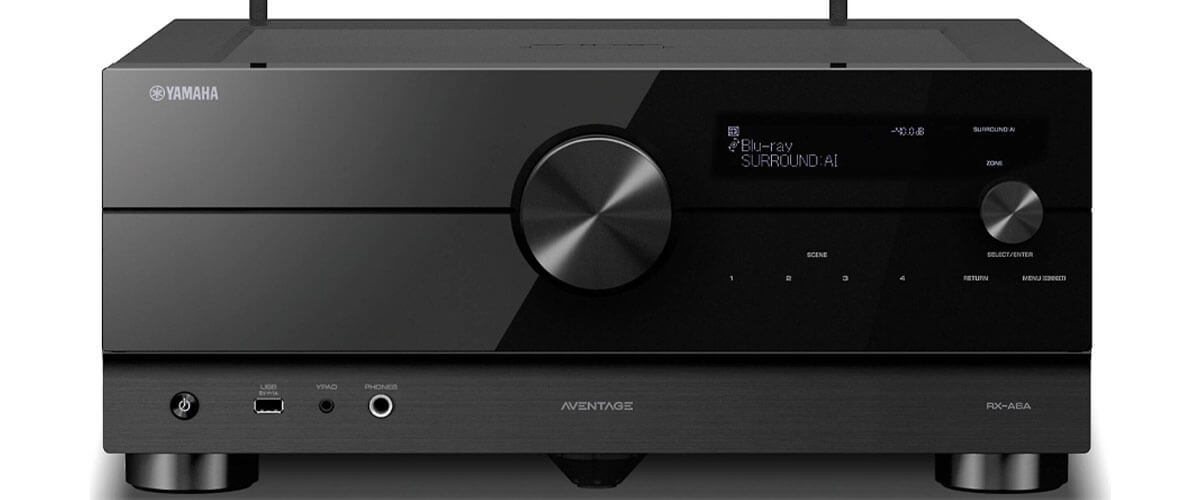
The Yamaha RX-A2A AV receiver is the entry-level model of Yamaha’s Aventage product line. At first glance, the device combines a reasonable price and an optimal set of functionality. So, surely I couldn’t skip this model while searching for receivers with Zone 2 feature.
Yamaha RX-A2A is a 7.1 AV receiver. Each channel provides up to 100 watts (6 ohms, THD: 0.09%, per channel, IEC). This model uses discrete amplifiers with a high output current and wide dynamic range, as well as high-end 384kHz / 32-bit DAC BB PCM5102A. The chassis is pretty standard but has additional anti-vibration support. The device supports Bi-amping. Also, the left and right front speakers are powered by independent amplifiers.

Just like other models from this review, the receiver also supports Zone 2 feature and allows for creating a classic 5.1+2 channel multi-room setup. I connected it to the TV in the main room and the radio in the second one working simultaneously. The RX-A2A can power all 7.1 channels in the main room even when the second zone is not in use. I truly enjoyed using 7.1 channel mode in the main room without any additional adjustments. I’m noting that this aspect is very important for multi zone home theater receivers.
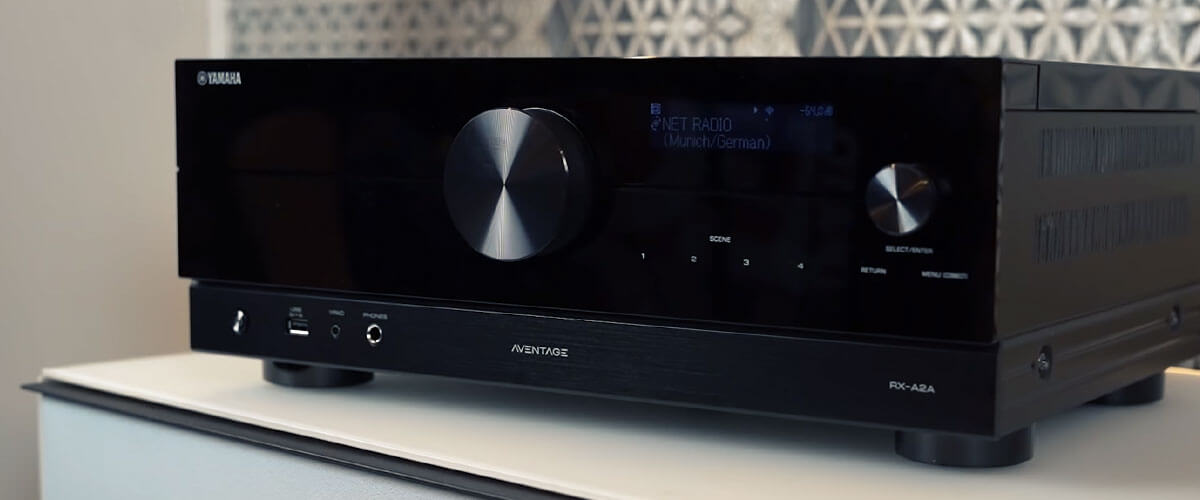
The RX-A2A has 7 HDMI inputs that support the 2.1 standards Airplay2, Music cast, and Bluetooth. Yamaha’s MusicCast app allows streaming of high resolution and lossless music formats, including proprietary ones, and supports Deezer, Tidal, Spotify, and Qobuz.
Despite the RX-A2A having HDMI with lower bandwidth compared to models in the Aventage product line, it showed itself pretty well. The device was easy to install and calibrate the sound. Compared to other models in this review, the receiver stands well for its price. It has a comprehensive set of features onboard, offers quite good sound, and has extensive streaming capabilities.
Key specs
- Channels: 7.2.
- Power output: 80W/8 Ohm.
- HDMI inputs/outputs: 7/1.
- Video functions: 8K/60Hz, 4K/60Hz, 4K/120Hz, HDMI Upscaling up to 4K.
- Bluetooth/Wi-Fi: yes/yes.
- Streaming services: AirPlay 2, Spotify, TuneIn, Deezer, Tidal, Netflix, Amazon Prime.
- Supports: HDMI ARC, HDMI eARC, HDMI CEC, HDCP2.3, HDR10+, Dolby Vision.
- Surround sound: DTS:X, DTS Virtual:X, Dolby Atmos, DTS HD Master, Dolby TrueHD.
Pros
- Built-in support of MusicCast.
- Full and rich sound output with enough power to fill large rooms.
Cons
- Only the “Standard” setting provides consistently good sound quality.
- Lack of additional features onboard.
- HDMI comes lower bandwidth.
We are supported by our audience. When you purchase through links on our site, we may earn an affiliate commission at no extra cost to you.
Our newsletter
* We will never send you spam or share your email with third parties

![Best Budget Receivers [Reviewed and Tested]](https://thetechholics.com/wp-content/uploads/2023/10/best-budget-av-receiver-300x150.jpg)
![Best 9-Channels AV Receivers [Reviewed and Tested]](https://thetechholics.com/wp-content/uploads/2023/10/best-9-2-receiver-300x150.jpg)

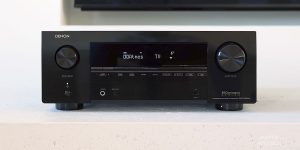
![Pioneer vs Denon Receivers [Top Models Compared and Tested]](https://thetechholics.com/wp-content/uploads/2023/10/denon-vs-pioneer-review-300x150.jpg)
